Some of the links in this post may be affiliate links.
You can’t beat the colorful foliage of Caladiums, whether you grow them indoors, outdoors, in the ground, or in pots! And there has been no shortage of questions and caladium problems from my readers. Here are some of the most common questions and problems that people often have with Caladiums (along with detailed answers.)
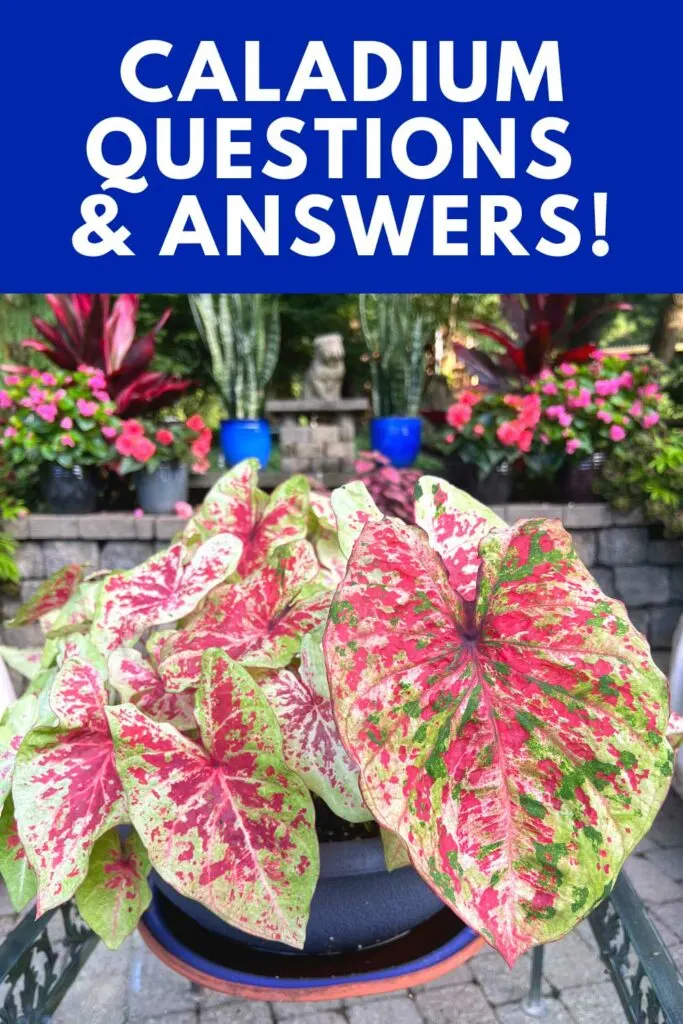
Caladiums are native to Central and South America and grow in tropical forest floors, river margins and other damp locations. They will go dormant seasonally and grow from bulb-like corms.
They love hot, humid growing conditions and need an evenly moist potting mix or soil while they are actively growing.
Table of Contents
CALADIUM PROBLEMS AND QUESTIONS…ANSWERED!
1. I planted my Caladium bulbs, but my plants are not full. Why?
The quality of Caladium tubers varies greatly when purchasing them, so if you can afford it, buy the highest quality ones that you can. Allow me to explain.
Good Caladium growers will produce top quality tubers that are vigorous and big. They are rated by size (jumbo size being the biggest followed by #1, #2 and #3). Large tubers normally have multiple “eyes” or growth points, whereas inferior quality ones often just have one.
Plant companies like Proven Winners “de-eye” the dominant eye on the tubers, and this results in multiple other sprouts to form, resulting in a bushier plant! It really pays to start off with high quality tubers.
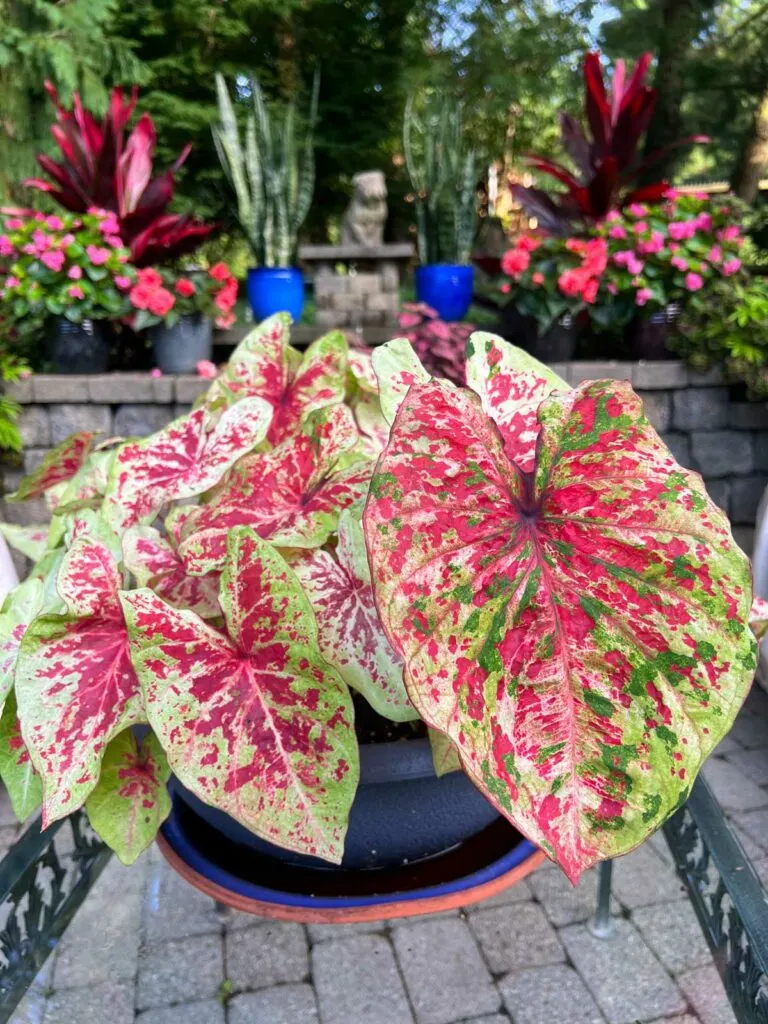
2. How do you plant Caladium bulbs?
It matters which end is up! Check out my blog post on planting Caladium bulbs to learn the best way to plant and care for your plants, along with details on how to overwinter them.
3. Are Caladiums annuals or perennials?
Caladiums are tropical perennials and they grow in Central and South America. They experience a dry and wet season and will go dormant during the dry season.
Many people living in cold climates will often treat these as annuals and just let them die when it gets cold. But you can store them in a dormant state and bring them back into growth in order to keep them from year to year.
If you live in zones 9 or 10 or warmer, these will grow year-round outside.
4. What should I do with my Caladium flowers?
Yes, Caladiums do flower, and they have the typical aroid-looking inflorescence. Here is what they look like. (They may look slightly different depending on your specific plant, but they generally look very similar.)
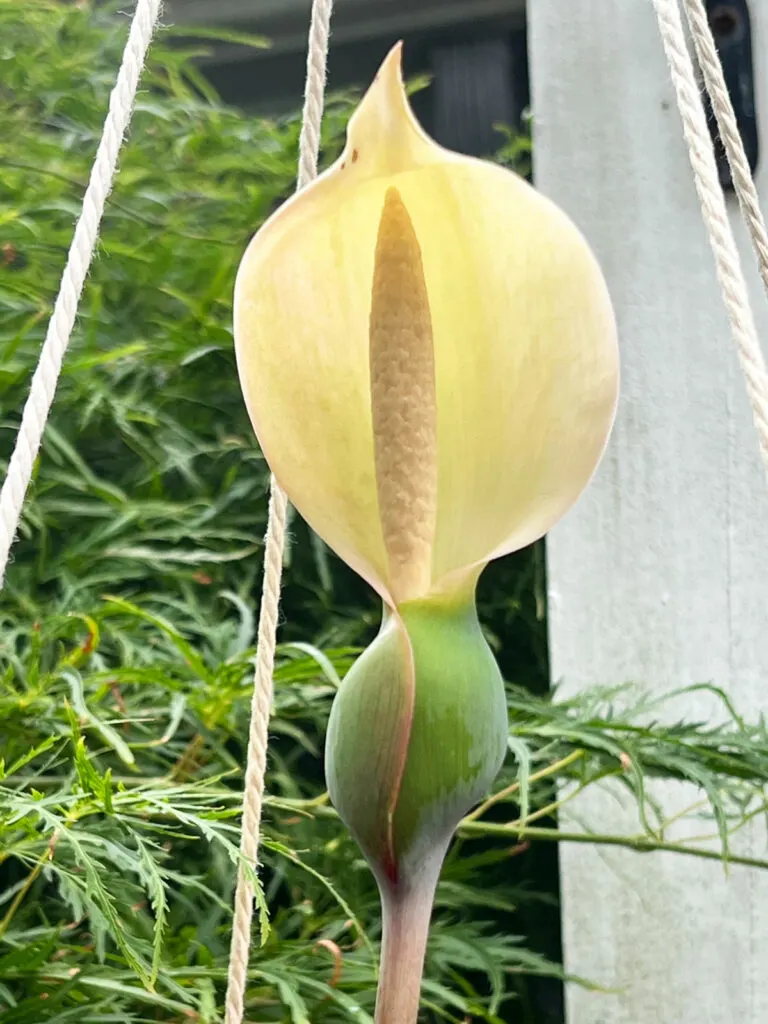
Whenever I notice my Caladiums flowering, I go ahead and cut them off. Why? Allowing the inflorescence to grow will take away energy from that plant that it could be using to grow more foliage and also produce more leaves.
And no one really grows these plants for the flowers right? So you’re best to cut them off.
5. Should I plant my Caladiums in the ground or in a pot?
It’s really personal preference and you can certainly do both, but here are some important things to keep in mind.
Caladiums like a light, well-drained, moist soil. If your soil in the ground is heavy clay, they will not like it. So you have two options at this point if you want to grow your Caladiums in the ground:
- Amend your soil with plenty of organic matter (compost or other organic material). It will improve the soil immediately, and even more over time if you keep adding organic material every year.
- If you don’t want to amend your soil, you can plant your Caladiums in a pot, and sink them in the ground so that they appear to be growing in the ground, but you get the advantage of better soil in your pot.
Or, of course, you can just keep them growing in containers. You will get nicer plants because you can control the potting mix that you use.
I like to use an all-purpose potting mix (like Miracle Gro or Espoma) to which I’ve added some perlite to fluff it up a bit.
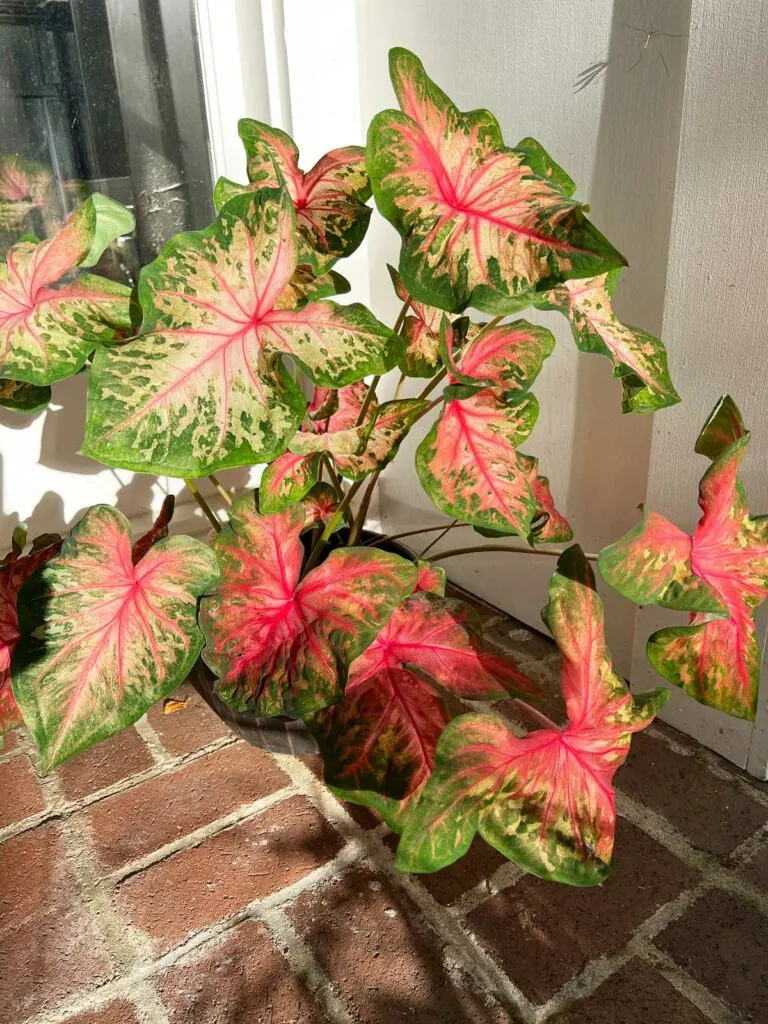
6. How much sun does a Caladium need?
This is a loaded question because it depends on whether you are growing them indoors or outdoors, and what your climate is like.
Most people think of Caladiums as shade plants, and they can certainly grow in the shade, but allow me to explain further.
If you are growing these indoors, it’s best if you give them a sunny window. For those of you that have read my book, Houseplant Warrior: 7 Keys to Unlocking the Mysteries of Houseplant Care, you know that there isn’t as much light as you’d think indoors.
And direct sun indoors is substantially less intense than direct sun outdoors, so give your Caladiums your sunniest window indoors.
Outdoors, if you live pretty far up North like I do, some direct sun is also great for Caladiums! If you live in an area of the country with really strong sun and hot temperatures, you may want to place yours in the shade, or in an area with morning sun only.
Regardless where you live, most Caladiums can easily take 4-6 hours of direct sun outside.
That being said, there are some varieties of Caladiums that have been developed to do well in the sun, such as Heart to Heart ‘Burning Heart’.
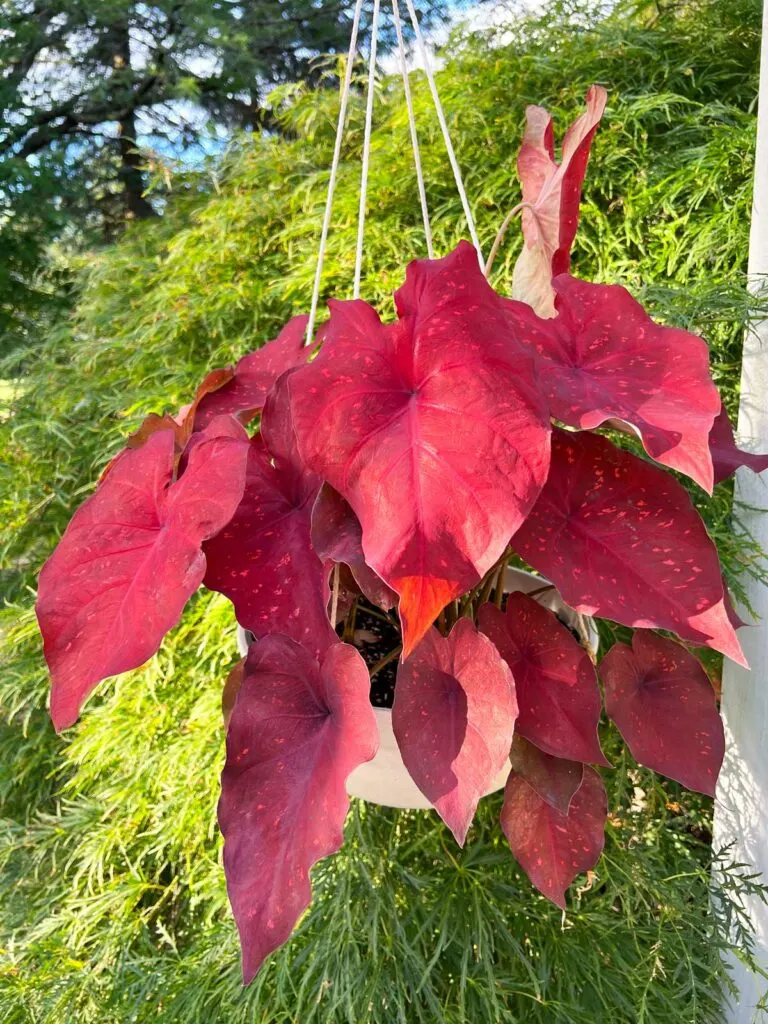
I have the plant in the photo above growing on my front porch in Ohio which receives several hours of sun, spanning from mid-day through the afternoon.
There are some things to look for that would indicate if your Caladium is getting too much direct sun. You may notice small holes with brown edges in the foliage. If you see this, move your plant to a shadier area.
7. Why is my Caladium not growing?
This could be due to multiple reasons. One factor that substantially affects growth is temperature. These plants will mope in cool temperatures. Keep your plants at 60°F or warmer for best growth.
If you try and move your Caladiums outside too early when temperatures are too cool, you could end up stunting your plants. Resist the urge!
Another reason could be keeping your potting mix or soil too dry, especially as your plants are getting established. They need good drainage, but never let your plants go completely dry. Allow the top inch or so to dry out before watering if you have your plants in pots.
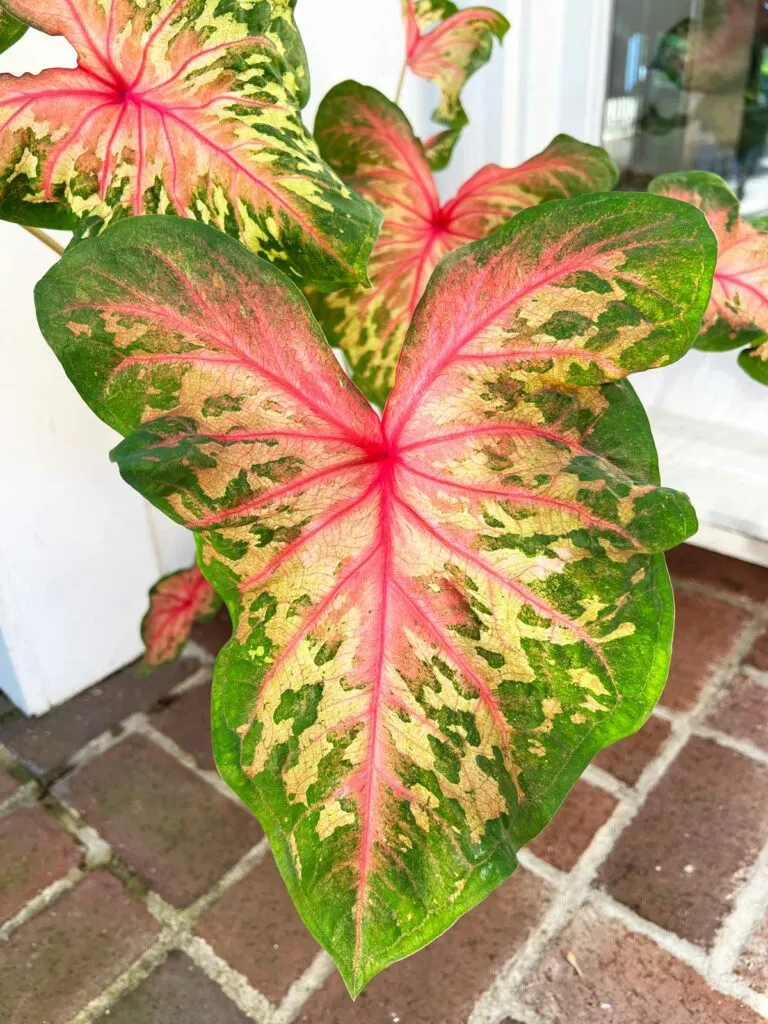
If you’re growing your Caladiums indoors, light is always a struggle. These are not good plants to place far from a widow. Light is #1 when it comes to plants growing so don’t forget this if you are growing these plants indoors.
Indoors, give your caladiums the sunniest window that you have.
8. I think I’m doing everything right, but my Caladiums are dying!
If you’ve been growing your plants indoors in pots, or you have them in pots outside and moved them indoors before it got too cold, it could just mean that your plant is entering its natural rest period!
By the time Autumn rolls around, you may start to notice your leaves are starting to collapse and fall over, despite good care. This is signaling that you should have your plant enter its natural dormancy period.
Stop watering completely, allow all foliage to die back, and then store the pot in a dark area that stays above 60°F for 1-2 months or so.
At that time, you can start watering again and place your plant back in a sunny window. You can also use this time to divide the tubers if you’d like.
9. Why are my Caladium stems bending?
If you’re nowhere close to when your plants are supposed to go dormant, and your petioles (“stems”) are bending and arching, some of this is perfectly natural! Especially if it’s happening to just one or two leaves.
But, if you’ve allowed your potting mix or soil to completely dry out, this will cause a lot of the petioles to arch and bend. Aim for an evenly moist potting mix.
The same can happen if you’ve kept your potting mix wet for too long and is experiencing root rot, particularly if your plant is sitting in water and has poor drainage.
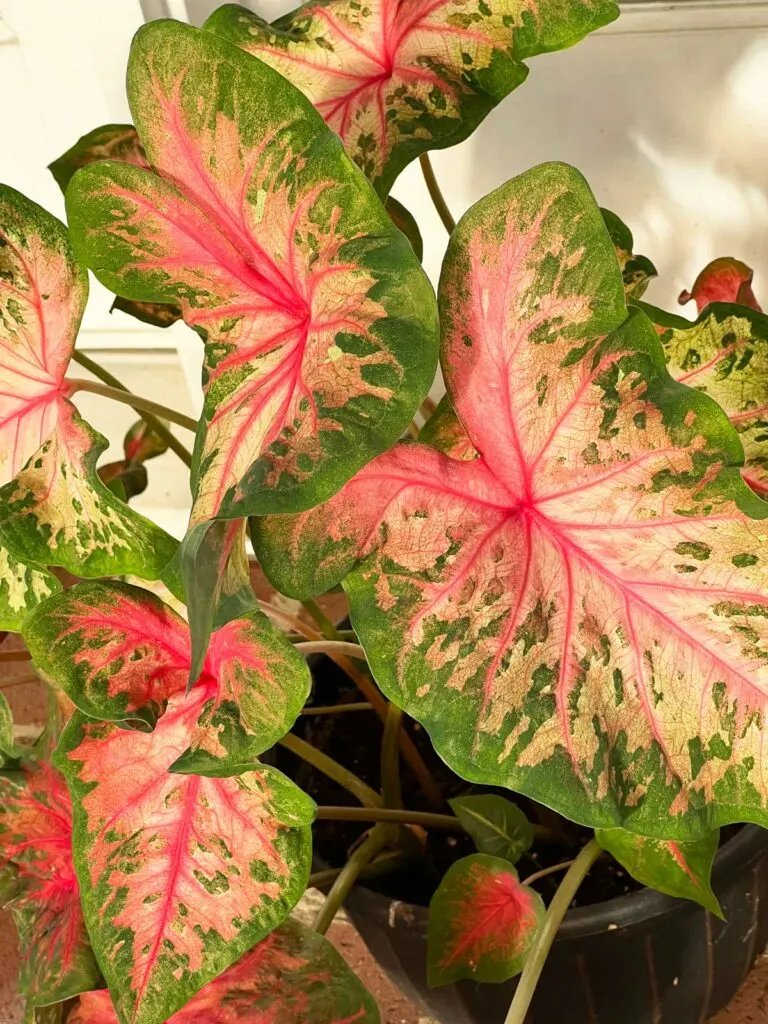
10. Why are my Caladiums getting yellow leaves?
Yellow leaves can be caused by a variety of issues, but most often, they are caused by soil that is too dry, or even soil that has been kept wet for too long. Unless of course your caladium is ready to enter its dormancy period…in which case there is nothing wrong!
Lastly, if you’d like to store your Caladiums, check out my blog post on storing Caladium tubers in a step-by-step post with photos.
I hope you’ve enjoyed this post on Caladium problems. Do you have any Caladiums? Comment below. I’d love to hear!


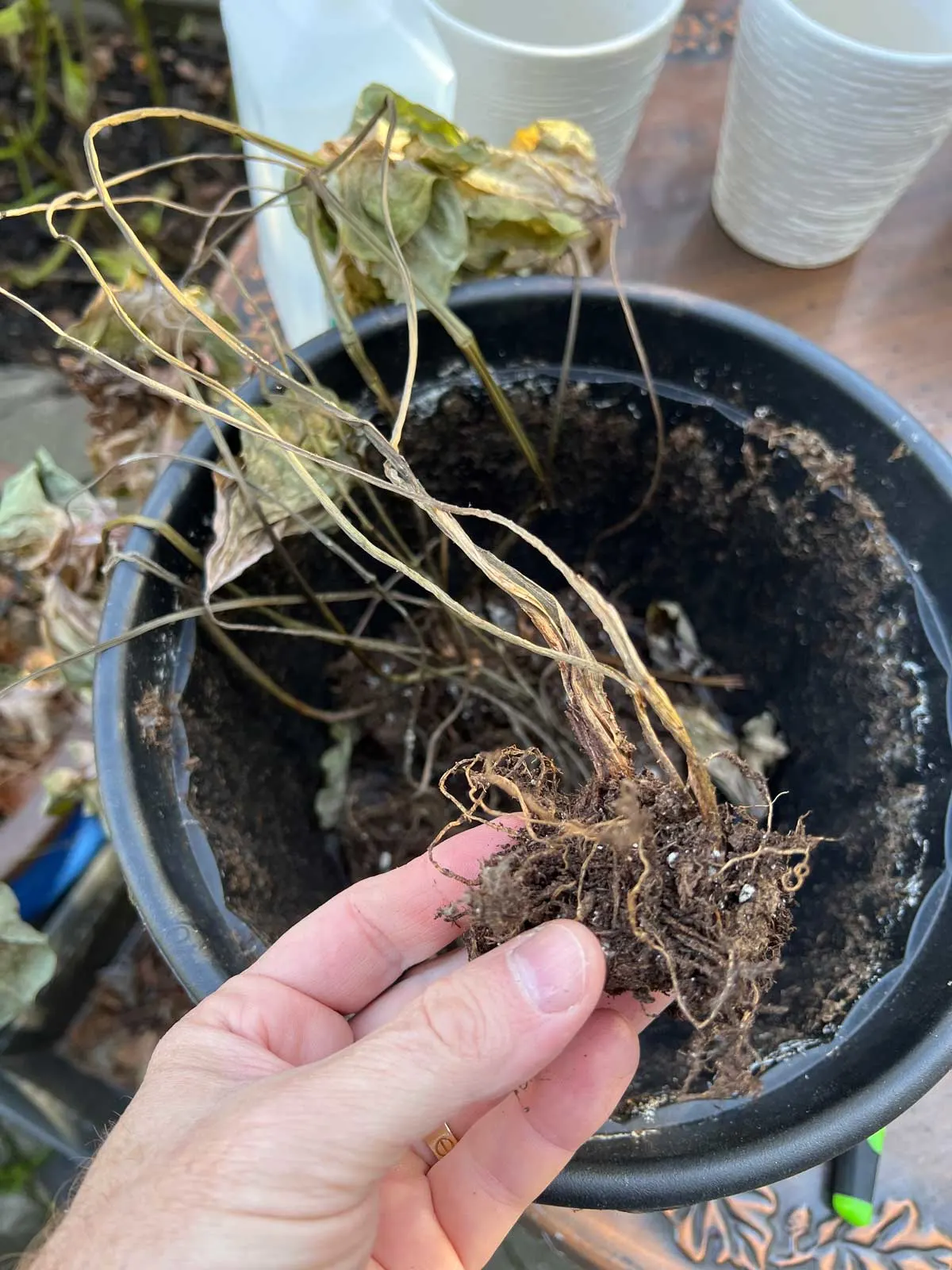
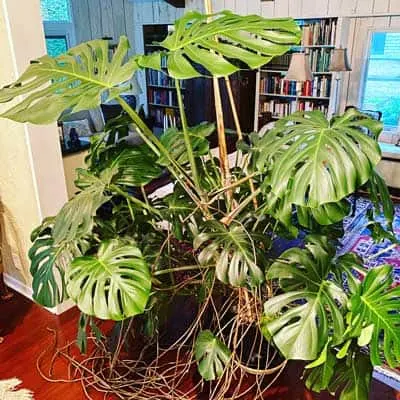
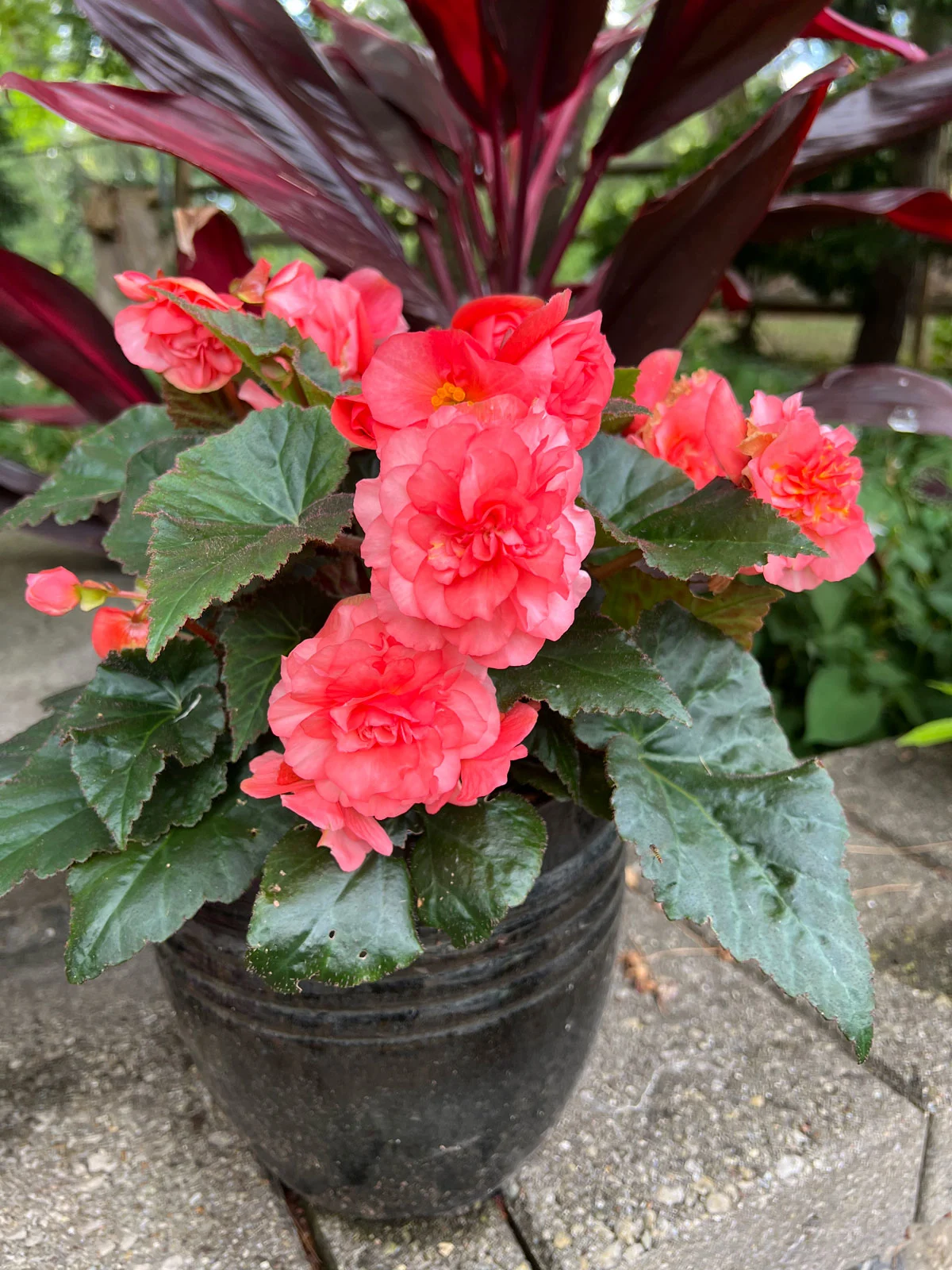
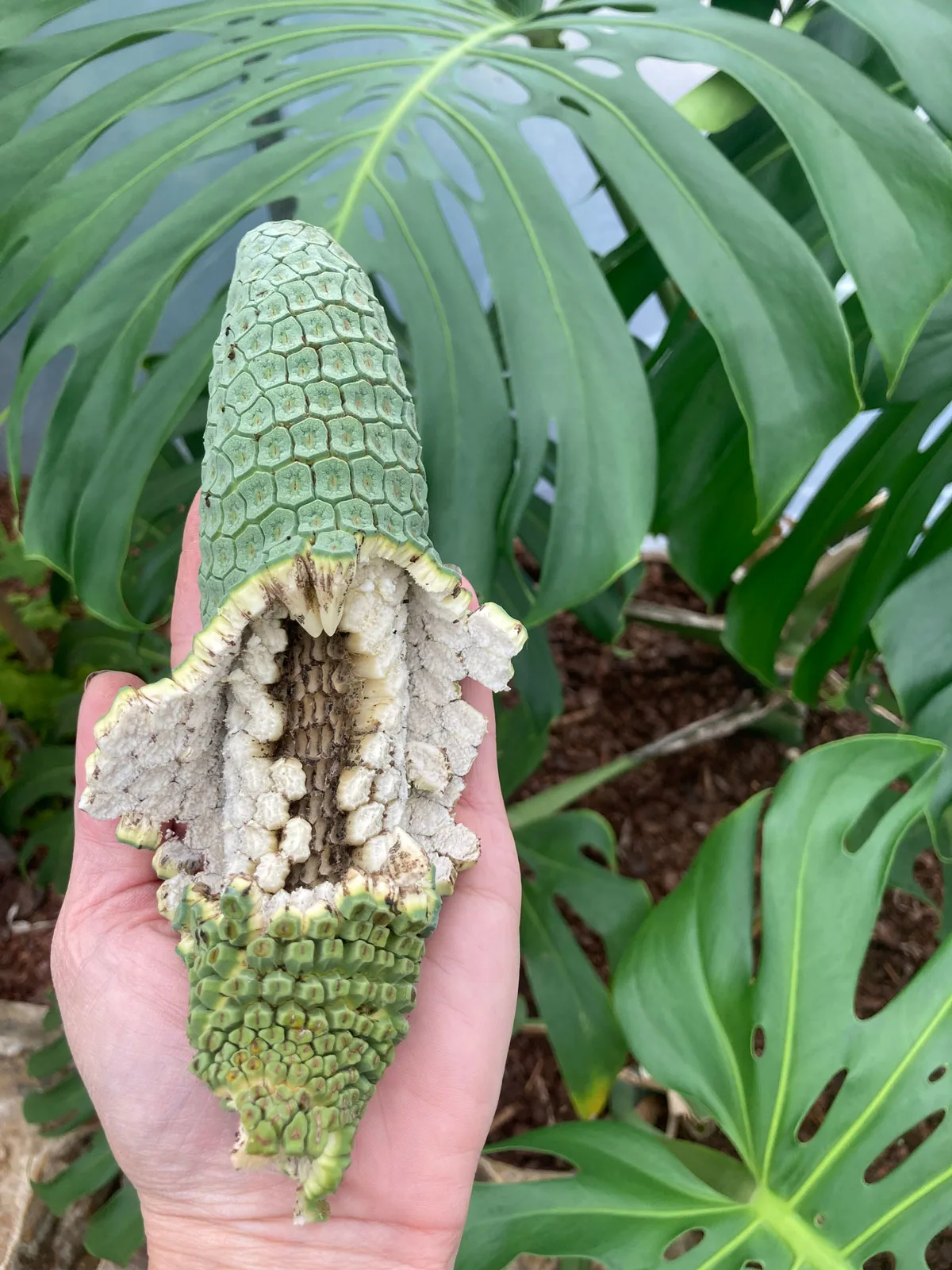
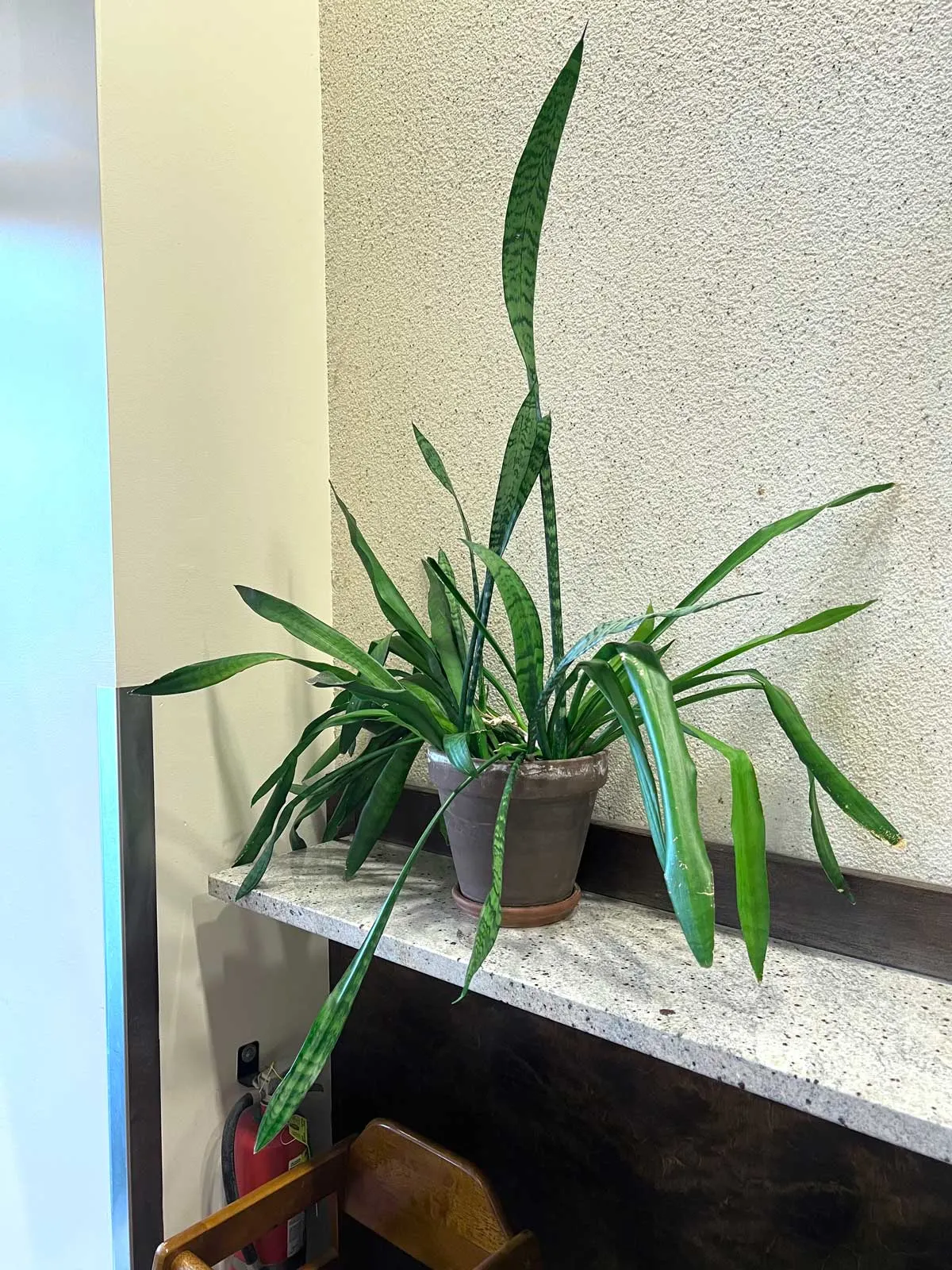
Marva Tyiska
Wednesday 4th of January 2023
I live in Texas, very hot in summer, cold in winter(30's to 50's in winter). I had a Rex Begonia on my patio, simply beautiful spring/summer but in winter not wanting it to freeze, I brought it inside and now it looks sick. How do I take care of it and restore to original beauty?
Raffaele
Wednesday 4th of January 2023
This is a common issue when bringing plants inside. There is a lot less light indoors than we think, and your plant is adjusting. Try putting it in a window that gets morning sun, and just give it a little time.